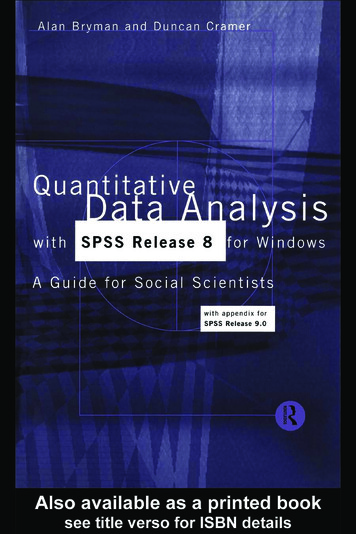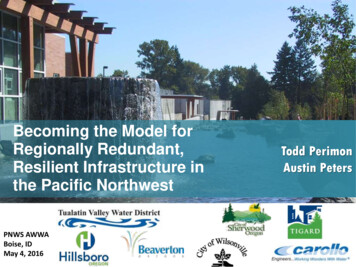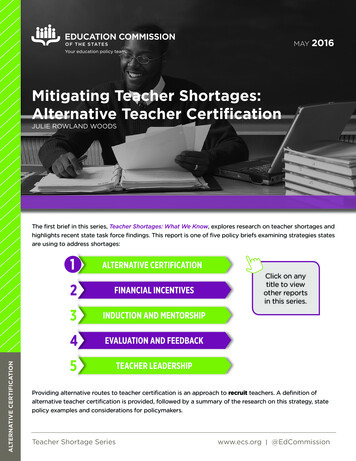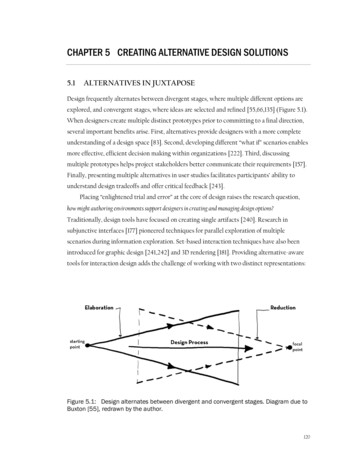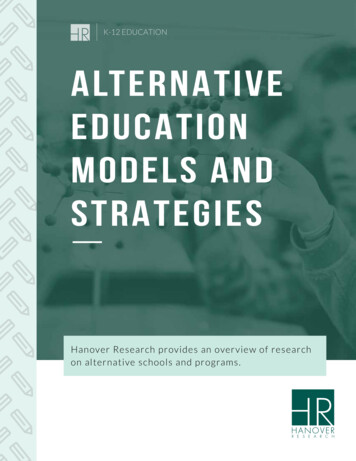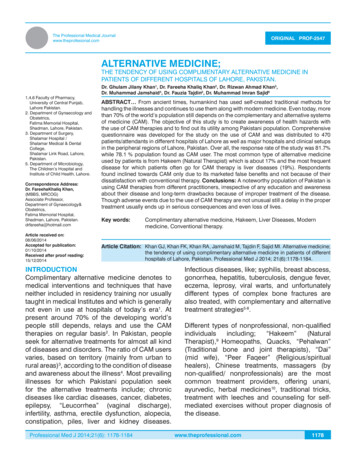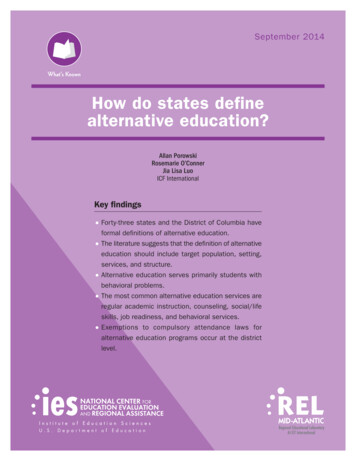
Transcription
September 2014What’s KnownHow do states definealternative education?Allan PorowskiRosemarie O’ConnerJia Lisa LuoICF InternationalKey findings Forty-three states and the District of Columbia haveformal definitions of alternative education. The literature suggests that the definition of alternativeeducation should include target population, setting,services, and structure. Alternative education serves primarily students withbehavioral problems. The most common alternative education services areregular academic instruction, counseling, social/lifeskills, job readiness, and behavioral services. Exemptions to compulsory attendance laws foralternative education programs occur at the districtlevel.U.S.DepartmentofEducationAt ICF International
REL 2014–038The National Center for Education Evaluation and Regional Assistance (NCEE) conductsunbiased large-scale evaluations of education programs and practices supported by federalfunds; provides research-based technical assistance to educators and policymakers; andsupports the synthesis and the widespread dissemination of the results of research andevaluation throughout the United States.September 2014This report was prepared for the Institute of Education Sciences (IES) under ContractED-IES-12-CO-0006 by Regional Educational Laboratory Mid-Atlantic administered byICF International. The content of the publication does not necessarily reflect the viewsor policies of IES or the U.S. Department of Education nor does mention of trade names,commercial products, or organizations imply endorsement by the U.S. Government.This REL report is in the public domain. While permission to reprint this publication isnot necessary, it should be cited as:Porowski, A., O’Conner, R., & Luo, J. L. (2014). How do states define alternative education?(REL 2014–038). Washington, DC: U.S. Department of Education, Institute of EducationSciences, National Center for Education Evaluation and Regional Assistance, RegionalEducational Laboratory Mid-Atlantic. Retrieved from http://ies.ed.gov/ncee/edlabs.This report is available on the Regional Educational Laboratory website at http://ies.ed.gov/ncee/edlabs.
SummaryAlternative education programs—broadly defined as educational activities that fall outsidethe traditional K–12 curriculum—frequently serve students who are at risk of schoolfailure. Because individual states or school districts define and determine the features oftheir alternative education programs, programs may differ in key characteristics, such astarget population, setting, services, and structure.The Maryland State Department of Education needed a clear definition of alternativeeducation programs to ensure compliance with Maryland Senate Bill 362, which callsfor raising the mandatory age of school attendance and lists enrollment in an alternativeprogram as an exemption from compulsory attendance. Because Maryland has no statewide regulation, definition, or standards for alternative education, the department neededa clear definition of alternative programs to ensure compliance with the bill’s provisions.In response to the Maryland State Department of Education’s request for support, Regional Educational Laboratory Mid-Atlantic reviewed information on alternative educationdefinitions and programs from state and federal websites and from local Maryland schoolsystem websites and found: Forty-three states and the District of Columbia have formal definitions of alternative education. The literature suggests that the definition of alternative education should includethe target population, setting (for example, within a school or in a standaloneschool), services, and structure (for example, during or outside of school hours). Alternative education serves primarily students with behavioral problems (35states). The most common alternative education services are regular academic instruction (21 states), counseling (14 states), social/life skills (13 states), job readiness (12states), and behavioral services (for example, anger management, conflict resolution; 11 states). Of the states that report where alternative education programs operate, 18 indicate that they allow alternative education programs to be held in separate schools;12 states indicate that alternative programs may be held within a regular school. Exemptions to compulsory attendance laws for alternative education programsoccur at the district level.i
ContentsSummaryiWhy this review?Definitions of alternative education varyWhy there is no standard definition112What the review examined3States define alternative education in various waysWhom do alternative education programs serve?Where do alternative education programs operate?What services do alternative education programs provide?3488Alternative education programs in Maryland are diverseWhom do alternative education programs in Maryland serve, and where do these programsoperate?What do alternative education programs in Maryland offer, and how are they structured?11Alternative education exemptions to compulsory attendance laws occur at the district levelHow do other states describe compulsory attendance laws and alternative educationexclusionary criteria?How do states implement alternative education exemptions to compulsory attendance laws?15Implications of the study17Study limitations18Appendix A. MethodologyA-1Appendix B. State definitions of alternative educationB-1Appendix C. Interview protocol for state education agencies on exclusionary criteria forcompulsory attendance lawsC-1Notes11131517Notes-1ReferencesRef-1Tables1 Grade levels and ages of students served according to alternative education definitions,by state52 Target populations for alternative education programs, by state63 Settings for alternative education programs, by state94 Services provided in alternative education programs, by state105 Target population and setting of alternative education program offerings in Marylandschool systems126 Services and structure of alternative education program offerings in Maryland school systems 14ii
7 Compulsory school attendance ages and exemptions, selected statesB1 Definitions of alternative education by stateB2 References for statutes, administrative codes, and other information on alternativeeducation used in this reportiii16B-1B-7
Why this review?Alternative education programs—broadly defined as educational activities that fall outsidethe traditional K–12 curriculum—include home schooling, general educational development (GED) programs, gifted and talented programs, and charter schools (Aron, 2006).Because individual states or school districts define and determine the features of theiralternative education programs (Lehr, Lanners, & Lange, 2003), programs may differ intarget population, setting, services, and structure.To ensure compliance with Maryland Senate Bill 362, which calls for raising the mandatory age of school attendance from 16 to 17 and exempts students enrolled in an alternativeeducation program, the Maryland State Department of Education requested assistance indefining and setting standards for alternative education in Maryland. When the age ofcompulsory attendance is raised to 17 on July 1, 2015, the Maryland State Departmentof Education must have a definition of alternative education in place so that local schoolsystems can apply the exemption appropriately.1To assist Maryland in defining alternative education, this study reviewed information onalternative education definitions and programs from state and federal websites and fromlocal Maryland school system websites. This identification of elements covered in statedefinitions of alternative education programs may also be useful to other state educationagencies that need to make informed choices about establishing or revising their own definitions of alternative education.Definitions of alternative education varyMost states have education programs, services, and options that are considered “alternative” (Lange & Sletten, 2002), along with formal definitions of alternative education intheir statutes and codes. In a 1998 survey of state coordinators of alternative education, 20states reported having adopted a definition of alternative education (Katsiyannis & Williams, 1998). By 2002, 48 states had some type of alternative education legislation, with 34states having a formal definition (Lehr, Tan, & Ysseldyke, 2008). However, there is littleconsensus among states on how to define alternative education.At the federal level an alternative school is defined as “a public elementary/secondaryschool that addresses needs of students that typically cannot be met in a regular school,provides nontraditional education, serves as an adjunct to a regular school, or falls outsidethe categories of regular, special, or vocational education” (Sable, Plotts, & Mitchell, 2010,p. C-1).This definition does not address alternative education programs within schools. Also,recent expansion of school, curriculum, and program types complicates the definition of“regular” schooling (Aron & Zweig, 2003). State definitions present additional complications. States structure and run alternative education programs differently. Even within astate, program emphasis can vary.1To assist Marylandin definingalternativeeducation, thisstudy reviewedinformationon alternativeeducationdefinitions andprograms fromstate and federalwebsites and fromlocal Marylandschool systemwebsites
Why there is no standard definitionThe lack of a commonly accepted definition of “alternative education” indicates the fluidity of related policies and legislation, the diversity of contexts and settings, and the variousgroups of at-risk youth who may benefit from alternative education options (Aron, 2003).Definitions of alternative education reveal several perspectives. One reflects the belief that“there are many ways to become educated, as well as many types of environments andstructures within which this may occur” (Morley, 1991, p. 8). Another focuses on students’education challenges and issues rather than students’ demographic characteristics or programmatic classification (Roderick, 2003).The most common view of alternative education found in the literature offers a concreteset of dimensions for defining and designing programs and schools (Aron & Zweig, 2003): Whom the program serves. Where the program operates. What the program offers. How the program is structured.These four dimensions reveal the complexity of developing a standard definition of alternative education. For example, the definition of a program on vocational training maydiffer from that of a program on credit recovery. Each of these dimensions offers manyopportunities for variation.Also complicating the task of reaching a standard definition is the changing nature ofalternative education. Today’s alternative schools look very different from the original alternative schools that emerged in the 1960s. Alternative education has evolved toembody a wide range of options to serve students with varying circumstances, interests,and abilities (Lange & Sletten, 2002). Alternative education settings have moved awayfrom private schools or special education programs to less traditional settings with specialized programs targeting specific groups of students. As alternative programs proliferateacross the country, the policies that govern them are also changing (Lange & Sletten,2002). But the current alternative education system shares the same philosophy as itspredecessors—“one size does not fit all” (Raywid, 1994).Whom the program serves. While some alternative education programs serve academically advanced students and students seeking vocational and technical education, most servestudents who are at risk of school failure or who are marginalized from the traditionalschool system (Lange & Sletten, 2002). In a national survey 64 percent of districts reported having at least one alternative school or program for at-risk students; these programsserved 646,500 students in the United States during the 2007/08 school year (Carver &Lewis, 2010).Targeting alternative education to specific groups of youth can drive the curriculum orapproach. For example, different alternative programs may be designed for pregnant orparenting teens, suspended or expelled students, recovered dropouts, delinquent teens,students with disabilities, students with high-risk health behaviors, and students seekingvocational and technical education.2The most commonview of alternativeeducation offersfour concretedimensionsfor definingand designingprograms andschools: Whomthe programserves, where theprogram operates,what the programoffers, and howthe program isstructured
Alternative education programs are often intended to support students who are underperforming academically, have learning disabilities, display emotional or behavioral issues, arevictims of other students with behavioral problems, demonstrate a high risk of droppingout of school, or display the need for individualized instruction (Coles et al., 2009). In asurvey of state-level policies on alternative education half the states indicated that alternative schools were designed to prevent students from dropping out of school (Lehr et al.,2008).Where the program operates. Program setting is related to the services provided (Aron,2003). Alternative education programs can be located in resource rooms within a traditional school, in schools within a school, or in self-contained alternative schools. Somealternative programs operate on community college campuses, at medical or mental healthfacilities, or in juvenile detention centers.What the program offers. Programs may offer regular high school diplomas, GED diplomas, or occupational certifications and often focus on basic life skills, good behavior inschool, and skills needed to enter the workforce (Cable, Plucker, & Spradlin, 2009).How the program is structured. Alternative schools and programs may be administeredor funded by a number of agencies, including state and local education agencies, charterschools, mental health institutions, juvenile justice agencies, federally funded programs,or private companies. Programs typically provide settings that are smaller than traditional classrooms, emphasize new educational methods and hands-on learning, have aflexible structure, and offer services and programs for individual and small group experiences (Cable et al., 2009). Education may be provided during or after school hours or onweekends.What the review examinedThis review addressed three questions: How do states define alternative education? What alternative education programs currently operate in Maryland? How have states developed alternative education exemptions to compulsory attendance laws?Data on alternative education definitions and programs from federal and state websites andfrom 24 local Maryland school system websites were examined to answer these questions.Phone interviews were conducted with representatives of education agencies in sevenjurisdictions (Delaware, the District of Columbia, New Jersey, Pennsylvania, Tennessee,Washington, and Wisconsin) to determine how definitions of alternative education dealwith the exemption from compulsory attendance laws of students in alternative educationprograms (see appendix A for a detailed description of the methodology).2States define alternative education in various waysDefinitions of alternative education were accessed from state department of educationwebsites of all 50 states and the District of Columbia, as well as from websites containingstate statutes and administrative codes. Forty-three states and the District of Columbia3In a survey ofstate-level policieson alternativeeducation half thestates indicatedthat alternativeschools weredesigned toprevent studentsfrom droppingout of school
had a formal definition of alternative education in 2013, compared with 22 in 1998 (Katsiyannis & Williams, 1998) and 34 in 2002 (Lehr et al., 2008).Consistent with the concrete set of dimensions for defining and designing programs andschools presented in the literature, the alternative education definitions and policies werereviewed on four dimensions: Whom the program serves (grade levels/ages and target population). Where the program operates. What the program offers. How the program is structured.The first three dimensions are described in this section; the fourth is described in thefollowing section on alternative education programs in Maryland. The unabridged definitions and applicable laws or administrative statutes are included in appendix B.Whom do alternative education programs serve?Grade levels and ages served. Twenty-eight states describe the grade levels or ages of students to be served by alternative education programs (table 1). Alternative programs tendto address students in the secondary grades, with 24 states serving high school grades and22 states serving middle school grades. Thirteen states explicitly include elementary schoolgrades; only four define students by age.Target population. Forty-two states include information about the target population foralternative education or the eligibility criteria for enrollment in an alternative program(table 2). Alternative education programs most commonly target students with behavioral problems (35 states), including students who disrupt the classroom and students whocommit severe disciplinary infractions and must be removed from regular education. Eighteen states target students with academic problems, including students with poor grades orlow standardized test scores and students who are behind in school credits. Eighteen statestarget students classified as “at risk,” a category that can encompass pregnancy, homelessness, dropout status, disciplinary problems, academic failure, absenteeism or truancy, drugor alcohol abuse, and physical or sexual abuse. Thirteen states specify general target populations and are directed at students who are unable to benefit from a regular school environment. Other states target students who are at risk of dropping out of high school or whohave dropped out (11 states) and students with truancy or attendance problems (9 states).Although not listed in table 2, other target populations identified in this review includestudents who are pregnant or parenting (six states), students caught engaging in substanceuse (six states), students whose parents are in legal or other trouble (for example, in jail orunder investigation by child protective services; three states), and English language learnerstudents (two states).Although state statutes and administrative codes usually specify the target populationsfor alternative education, it is unclear in many cases whether the target populations aresuggested or prescriptive. Some states, such as Iowa, provide very specific criteria for enrollment in alternative programs (students have to be at risk, which is defined as meeting1 of 13 specific criteria). By contrast, Georgia’s code—which takes a broad approach—stipulates that “alternative education programs are intended to meet the education needs4Twenty-eightstates describethe grade levels orages of studentsto be servedby alternativeeducationprograms
Table 1. Grade levels and ages of students served according to alternative education definitions, by stateMiddleschoolstudentsHigh schoolstudentsAlaska Arizona StateElementaryschoolstudentsStudentsdefined byage (ratherthan grade)CommentsAlabamaArkansas CaliforniaColoradoConnecticut DelawareOffered during periods of expulsion for students under16 and for students ages 16–18 on their first expulsion Intended primarily for students in the secondarygrades (grades 6–12) Grades 7–12 Grades 4–12 District of ColumbiaFloridaGeorgiaHawaiiIdahoIllinois IndianaIowaKansasKentuckyLouisiana MaineMarylandMassachusetts Michigan Minnesota MississippiMissouri Grades K–12Elementary and secondary grades (grades K–12) Compulsory school ages (ages 6–17 or age 5 ifenrolled in full-day kindergarten) Students must be ages 16–21 and have been droppedfrom the regular school program to be eligible forfoundation aid payments in the alternative programMontanaNebraskaNevadaNew Hampshire New JerseyNew MexicoNew York North CarolinaNorth DakotaOhio OklahomaOregon Pennsylvania(continued)5
Table 1. Grade levels and ages of students served according to alternative education definitions, by eschoolstudentsHigh schoolstudents Studentsdefined byage (ratherthan grade)CommentsRhode IslandSouth CarolinaSouth DakotaTennessee TexasGrades 1–12 Students must be ages 10–21 to participate in theJuvenile Justice Alternative Education Programs;no age specified for participation in the DisciplinaryAlternative Education ProgramUtahVermont VirginiaWashingtonWest VirginiaWisconsin WyomingTotal1322244Note: Blank cells indicate that the state definition does not specify the grade level or age of students served.Source: Review of state definitions, legislative statutes, administrative codes, and department of education websites.Table 2. Target populations for alternative education programs, by dentswithacademicproblemsAt-riskstudents Studentsunable tobenefit fromregularschoolStudentswho havedropped outStudentswithtruancy orattendanceproblems AlaskaArizona Arkansas CaliforniaColorado Connecticut Delaware District of Columbia Florida Georgia Hawaii Idaho Illinois Indiana Iowa Kansas(continued)6
Table 2. Target populations for alternative education programs, by state ble tobenefit fromregularschoolStudentswho havedropped out Studentswithtruancy orattendanceproblemsKentuckyLouisiana MaineMarylandMassachusetts Michigan Minnesota Mississippi Missouri Montana Nebraska Nevada New Hampshire New Jersey New MexicoNew YorkNorth Carolina North Dakota Ohio Oklahoma Oregon Pennsylvania Rhode Island South Carolina South DakotaTennessee Texas Utah Vermont Virginia WashingtonWest Virginia Wisconsin 3518 WyomingTotal1813119Note: Blank cells indicate that the state definition does not specify the target population.Source: Review of state definitions, legislative statutes, administrative codes, and department of educationwebsites.of a student who is suspended from his or her regular classroom and also of a studentwho is eligible to remain in his or her regular classroom but is more likely to succeed in anontraditional setting such as that provided in an alternative education program” (OfficialCode of Georgia, Annotated [O.C.G.A.], § 202154.1, 2010). It is unclear how strictly thesecriteria are enforced.7
Where do alternative education programs operate?Thirty-four states specify possible locations for alternative education programs (table 3).Eighteen states allow for alternative programs at separate sites or school facilities. Twelvestates mention alternative education programs within regular schools. And six statesmention accredited schools or schools affiliated with accredited schools. Separate sites mayinclude community colleges, recreation centers, and neighborhood organizations. Othersettings include home schooling, online learning, and juvenile justice facilities. Althoughstate statutes and administrative codes provide examples of settings and locations for alternative education programs, the identified settings are not intended as exhaustive lists.What services do alternative education programs provide?In the operational definitions of alternative education, 39 states include guidance on services that should or might be provided, as indicated in official state definitions, legislative statutes, administrative codes, or department of education website content (table 4).3Although regular academic instruction is implied, only 21 states explicitly include thiscomponent in their operational definition. Other elements of academic instruction foundin state guidance include remedial education, content area instruction (for example, mathand reading), evidence-based curriculum, active learning, small group learning, digitallearning, tutoring, and academic support.Fourteen states include counseling services in their guidance on alternative education programs. Since many programs target students with behavioral problems, it is not surprisingthat 11 states mandate (or suggest) behavioral services, which include conflict resolution,anger management, positive behavioral supports, behavioral shaping, and cognitivebehavioral interventions.Thirteen states specify social skills and support services, including social skills development, life skills instruction, and skills to increase employability and success in the community. Twelve states provide career education, which includes workplace or job training,vocational education, career readiness, and career counseling.Twelve states mention other services, including transportation, daycare or childcare,health services, credit recovery, special education services, individual service plans, substance abuse interventions, and links to community partners.Program services are diverse. For example, in California the social skills and support services are designed to maximize student motivation and self-directed learning. They alsofocus on building cooperative learning among students, teachers, and parents. Alabama’ssocial skills and support services emphasize anger management and strategies for developing self-control.8In the operationaldefinitions ofalternativeeducation, 39states includeguidance onservices thatshould or mightbe provided, asindicated in officialstate s, ordepartmentof educationwebsite content
Table 3. Settings for alternative education programs, by stateStateSeparate site orschool facilityAlabamaIn schoolAccredited oraffiliated withaccredited schoolOther Alaska ArizonaArkansas California Colorado Connecticut Delaware District of Columbia FloridaGeorgia Hawaii Idaho IllinoisIndiana IowaKansasKentucky Louisiana MaineMarylandMassachusetts MichiganMinnesota Mississippi MissouriMontana NebraskaNevada New HampshireNew JerseyNew Mexico New York North CarolinaNorth DakotaOhioOklahomaOregon Pennsylvania Rhode IslandSouth Carolina South Dakota Tennessee Texas (continued)9
Table 3. Settings for alternative education programs, by state (continued)StateSeparate site orschool facilityUtah In schoolAccredited oraffiliated withaccredited schoolOther69VermontVirginiaWashington West Virginia Wisconsin WyomingTotal1812Note: Blank cells indicate that the state definition does not specify the setting.Source: Review of state definitions, legislative statutes, administrative codes, and department of educationwebsites.Table 4. Services provided in alternative education programs, by stateRegularacademicinstructionCounselingSocial skillsand supportCareereducationBehavioralservicesAlabama Alaska StateOther ArizonaArkansas California Colorado Connecticut District of ColumbiaDelaware Florida Georgia Hawaii Idaho Illinois IndianaIowa KansasKentucky Louisiana Maine MarylandMassachusettsMichigan Minnesota Mississippi MissouriMontana(continued)10
Table 4. Services provided in alternative education programs, by state raska Nevada StateSocial skillsand supportCareereducationBehavioralservices New HampshireNew JerseyOther New MexicoNew York North Carolina North DakotaOhio Oklahoma Oregon PennsylvaniaRhode IslandSouth Carolina South Dakota Tennessee Texas UtahVermontVirginia Washington West Virginia Wisconsin WyomingTotal2114131211Note: Blank cells indicate that the state definition does not specify the services provided.Source: Review of state definitions, legislative statutes, administrative codes, and department of education websites.Alternative education programs in Maryland are diverseThe review included a web search of alternative education programs in Maryland’s 24school districts.Whom do alternative education programs in Maryland serve, and where do these programs operate?The web search identified 89 alternative education programs in Maryland and found that22 of 24 local school systems included information on alternative programs on their websites. Of these 22 local school systems, all served secondary school students, and 7 alsoserved primary school students.The review identified the characteristics of target populations for each alternative education program. Fifty-seven programs (64 percent) targeted students with behavioral problemsor who were in contact with law enforcement, 54 (61 percent) targeted students who werehaving academic difficulties as evidenced by low grades or being behind grade level, and22 (25 percent) targeted students with attendance problems (table 5). Less common target1112
Table 5. Target population and setting of alternative education program offerings in Maryland schoolsystemsWhom the program servesLocal schoolsystemNumber b26–1212Allegany CountyWhere the program operatesPregnant orAttendancec parenting10Inschool1SeparateOutside of site/schoolschoolfacility01Anne ArundelCounty16K–126882655Baltimore 5Calvert County26–122110101Caroline County16–121000001Carroll County5PK–122200005Cecil County1K–121000100Charles Frederick County16–121100001Garrett County39–120000120Harford County2K–121211002Howard County8K–128601503Kent ce George’sCounty76–126420214Queen Anne’sCounty16–121000001St. 100001Talbot micoCounty26
school), services, and structure (for example, during or outside of school hours). Alternative education serves primarily students with behavioral problems (35 states). The most common alternative education services are regular academic instruc-tion (21 states), counseling (14 states), social/life skills (13 states), job readiness (12

